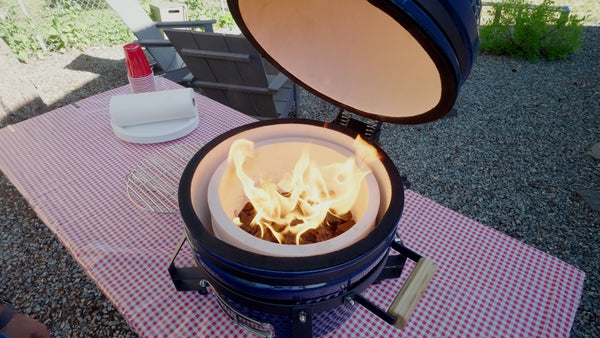
High-Heat Grilling Techniques — Searing, Caramelizing, and More
That irresistible crust on a perfectly grilled steak, the sweet char of caramelized vegetables—these are the hallmarks of high-heat grilling techniques. Mastering intense heat is a core skill for any grill master, transforming simple ingredients into flavor-packed showstoppers. Whether you’re using a kamado, charcoal, or gas grill, this guide will help you unlock the secrets of searing meat grilling, caramelizing vegetables on the grill, and more.
What is High-Heat Grilling? The Science of Sizzle
High-heat grilling means cooking at temperatures above 450°F (232°C), often reaching 600°F+ (315°C+). At these temps, the Maillard reaction—a chemical process between amino acids and sugars—creates deep browning and complex, savory flavors on the food’s surface. Caramelization happens as natural sugars brown, especially in vegetables and fruits, adding sweet, nutty notes. The intense heat rapidly dehydrates the exterior, forming a delicious crust that locks in moisture for the perfect sear BBQ. For more on the science, see Understanding the Science of Smoke and Meat.
Why Grill at High Heat? Benefits Beyond the Burn

-
Superior Flavor: High heat develops rich flavors through the Maillard reaction and caramelization.
-
Amazing Texture: Achieve a crispy, flavorful crust while keeping the interior juicy.
-
Speed: Perfect for fast grilling techniques—thin cuts and vegetables cook in minutes.
-
Aesthetic Appeal: Produces those sought-after grill marks and a professional finish.
-
Juiciness: While searing doesn’t “seal” juices, a quick crust helps minimize moisture loss.
Setting Up Your Grill for High Heat
-
Fuel Selection:
-
Lump Charcoal is king for charcoal grilling high heat—it burns hotter and lights quickly. Use a full chimney for maximum output.
-
Gas Grills: Turn all burners to high and preheat thoroughly.
-
Airflow Control:
-
Open top and bottom vents fully on charcoal/kamado grills to maximize oxygen and heat (how to control temperature in a kamado grill).
-
Preheating:
-
Allow 15–30 minutes (or longer for kamados) to reach target temps. Grates must be extremely hot—use a Vessils Grill Thermometer for accuracy.
-
Grill Grates Matter:
-
Cast iron grates retain and transfer heat best for searing (Vessils Cast Iron Cooking Grates), while thick stainless steel is also excellent. Learn more in Grilling Enthusiasts: Understanding the Different Types of Grill Grates.
Key High-Heat Grilling Techniques
-
Direct Searing:
Place food directly over the hottest part of the grill. Sear for 1–3 minutes per side to develop a crust—ideal for steaks, chops, burgers, and shrimp. -
Reverse Searing:
For thick cuts, start with indirect low heat (225–275°F) until nearly done, then finish with a blazing sear over direct heat. See Chefs and Home Cooks: How to Choose the Right Cooking Temperature for Grilling. -
Charring Vegetables:
Grill veggies like corn, peppers, and asparagus directly over high heat, turning often for even caramelization. -
Flash Grilling:
Use for very thin cuts (skirt steak, fish fillets): extremely high heat, less than a minute per side.
Foods Best Suited for High-Heat Grilling
-
Meats: Steaks (ribeye, strip, porterhouse), thick pork chops, chicken thighs/drumsticks, burgers, shrimp.
-
Vegetables: Asparagus, bell peppers, zucchini, corn, onions.
-
Fruits: Pineapple, peaches—great for caramelization.
Essential Tools for High-Heat Grilling
-
Grill brush (for clean, hot grates)
-
Long-handled tongs (for safe flipping)
-
Heat-resistant gloves (for safety)
-
Instant-read thermometer (for doneness)
-
Oil with high smoke point (for grates/food)
Tips for High-Heat Grilling Success
-
Pat meat dry for better searing.
-
Lightly oil grates or food to prevent sticking.
-
Don’t overcrowd—allow airflow and even heat.
-
Keep the lid closed as much as possible.
-
Know your grill’s hot spots and use them.
-
Rest meat after cooking for juiciness.
Troubleshooting Common High-Heat Issues
-
Flare-Ups: Caused by fat drippings; move food to indirect heat, close lid, trim excess fat (Kamado Grill Safety Tips).
-
Burnt Outside, Raw Inside: Use two-zone cooking or reverse sear for thick cuts.
-
Sticking: Ensure grates are hot, clean, and lightly oiled.
-
Excess Smoke: Aim for thin blue smoke, not thick white.
Conclusion: Ignite Your Inner Grill Master!
High-heat grilling is the gateway to incredible flavor, texture, and speed. With the right setup, tools, and techniques, you can command the flame like a pro. Ready to put these skills to the test? Explore Vessils' premium grills and accessories for sizzling, delicious results every time.
